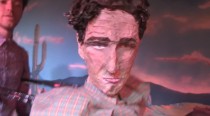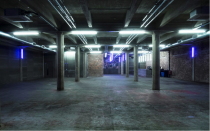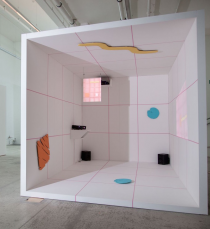While exhibiting a new moving image work, ‘Alchemist’ at Glasgow International recently, which was a one room dual screen installation, one of the visitors coming out said “I just don’t get it, all this video everywhere… doesn’t anyone make art anymore?” This small comment, all too easily dismissed, has caused me to reflect upon why I use this medium, what actually motivates me to work in this way. What is it about the moving image that might provoke this reaction? – some would say it is too closely related to the ‘represented real’, containing much less of the presence of the artist than, say, a painting. The second aspect is that moving image art moves.
I will begin by describing a moment I had a few days after finishing the show at Glasgow, while on a road trip with Richard Demarco which traced the historic journey that Joseph Beuys made to Rannoch Moor and Oban.
“I am standing right on the edge of the pier at Inverary, looking out across a sea loch at dusk. It seems at first view of permanence. Looking down, I see a world in motion, the solid ground replaced by the endlessly moving, reflecting surface of the water. I look across at the hills, formed once by massive volcanic activity, glaciers, millions of years of weather erosion, still eroding. I consider the movement of tectonic plates, discussed usually in lessons of how this country was formed. Yet still they are moving, separating, joining, creating fissures, oceans and mountain ranges. The wavelets beneath my feet lend to this contemplation of geological time their sense of movement, of time sped up, the whole earth forming and deforming, a constant flux. And then, imagining myself transported in time to this very spot before the earth itself were formed, I wonder would this spot even exist, or be contracted to non-existence? I wonder how these waves would look a few seconds ago, or tomorrow. I imagine myself standing upon the loch floor, looking up at the surface movements, not down upon them. I imagine myself looking down from the moon, or looking at the water surface from two inches away. Were I, at this very moment, even to be transported to the other side of the loch, everything would be changed, my experience of this moment changed quite completely. Surveying the scene I perceive, it is just one view of constant movement, and all I can take from it are a flow of momentary perspectives among an infinite number. A complex sampling of an impossibly large total reality. As the number of perceptions and possible perceptions begin to flood in, of an eternity of time, an infinitely varied dynamic of movement, infinite possible perspectives, any ability I might have to process them is overwhelmed. I become quite dizzy with a kind of psychological motion sickness, and turn away.”
What is happening here? It is neither a purely objective, nor a purely subjective experience. It is certainly not transcendent; there is no other place reached here, just a dizzying and overwhelming onslaught of thought, memory, imagination and actual perception upon my consciousness. On one level it represents a kind of oscillation between the subjective and objective, between the imagination and the world of matter. It is observational, but equally it is a dynamic interplay of thought, memory, imagination and knowledge. It is from this dynamic that creative thought emerges. But it is also an essentially failed attempt to penetrate the flux of fluid reality. It is a failure, because in perception I cannot grasp the thing itself, because the thing in itself is impossibly large, impossibly fluid, and ungraspable. And if perception fails, what chance does art have? In this sense, I must describe all my work as a catalogue of failure, of death.
But, returning to the moving image vs the static image in a work of art, the first point to make is that the moving image never shows us reality, even in the most apparently ‘real’ of images. To choose a slice of temporal reality, frame a shot, record it, present it – all of this is a profound abstraction of a moment of perceived time and reality. It is as illusory in itself as the most abstract of abstract works of art. But, perhaps more profoundly, moving image art deals with movement and with duration. It is this aspect, in its inherent fluidity, that it comes closer to philosophical truth, for me at least, than any fixed image ever can. A painting for instance, can contain duration in its creation, but the moment it is finished, it appears as a fixed image, and fixed idea, and it begins to die. Its temporal dynamism is no longer situated in the medium of the work itself, but transferred, more or less successfully, to the subjective experience of the viewer. The most interesting thing for me, for example, about Malevich’s black square is not its fixed conceptual significance (supposedly containing at once the negation and immanence of everything), but its element of actual duration, the way in which the paint on this fixed image of an idea has degraded over the nearly 100 years since it was painted. It is now no longer a flat black square, but has become dynamic image of degrading, cracking blackness. Nothing wants to be fixed in time.

So, I believe the moving image comes closer to reflecting the duration, fluidity and dynamism of life. It still fails, but it comes closer. But the fact of its fluidity challenges the way we are used to looking at art and as such, becomes problematic. A fixed image invites an entering into a fixed idea, a fossilized sample that can be looked at again and again with the same result, or even with deepening engagement, but always centered around a fixed point. In a contemporary context, this is something audiences and curators want from art. We want to ‘get it’, to understand the fixed point, the idea, the concept. We are more comfortable and satisfied with work we can intellectually grasp, work we can fix, frame and contain within our cultural context. But all of these fixed concepts represent only lifelessness. Moving image art has the potentiality of fluidity, a potentiality to contain within its form a multiplicity of perspectives, a fluidity of ideas and a life of dynamic concepts.
However, I must admit this potentiality is often both problematic and unrealized within a contemporary art context. The deathly characteristic of the fixed concept is still prevalent in much of the more acclaimed moving image art we see today. Many moving image works are celebrated for their slight, banal, singular ideas, or even their very emptiness. My argument moves against this trend, toward a celebration of complexity and fluidity of idea, form and concept that truly honours the medium. I shall end this post with a quote from Gilles Deleuze:
“The screen itself is the cerebral membrane where immediate and direct confrontations take place between the past and the future, the inside and the outside, at a distance impossible to determine, independent of any fixed point.”














Comments